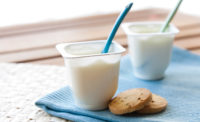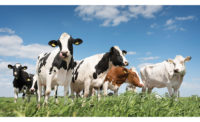Organic dairy matures, finds new areas for growth
Now an established category, organic finds new growth through grass-fed and full-fat products








What used to be associated with granola-crunching hippies and co-ops has long since become mainstream: Consumers can now find organic food everywhere, from their local farmer’s market to Walmart.
Some of the best-selling organic products in the United States are dairy ones, especially milk. In fact, according to “2019 U.S. Beverage Market Outlook” from the Packaged Facts division of Rockville, Md.-based MarketResearch.com, household use of organic milk has been increasing since 2008.
“In 2010, 4% of the households surveyed used organic milk,” the report says. “By 2018, that had more than tripled to 13%.”
But the popularity of organic dairy may have hit a plateau. According to the Organic Trade Association’s (OTA) “2019 Organic Industry Survey,” after years of higher growth, 2018 was the second year in the row that the U.S. organic dairy sector experienced a slowdown. Organic dairy (and egg) sales were up just 0.8% over 2017 sales.
Packaged Facts points out that overall milk sales have fallen by double digits since 2000, making organic milk a bright spot in the dairy world. This may be partially due to consumer desire for cleaner labels and healthier products. According to Heather Engwall, vice president of marketing for Emmi Roth USA, Fitchberg, Wis., organic dairy fits the bill.
“With the transparency of social media, consumers are more aware of the supply chain and what goes into the food they choose to feed their families,” she said. With this new transparency, informed consumers look for the organic label because they associate it with better quality and fewer ingredients.
Educated consumers
Many of the brands with which Dairy Foods spoke said they’ve seen an increasing tendency toward value-based shopping that has led many to choose organic dairy.
According to the brand team of La Farge, Wis.-headquartered Organic Valley, there are many reasons people choose organic. Some consumers are looking for no chemicals or antibiotics in their food and beverages, others for more ethical treatment of animals or sustainable farming.
“People are shopping for food and dairy products with fewer additives and chemical inputs,” the team said. “But we also connect with our consumers through shared values, like higher standards of treatment for farm animals, a sustainable approach to farming and business, and helping rural communities thrive through small family farms and organic agriculture.”
Albert Straus, founder and CEO of Petaluma, Calif.-based Straus Family Creamery and an organic dairy farmer himself, concurred. He said supporting brands that align with one’s values is especially prominent among Generation Z shoppers, who tend to care more about environmental impact.
“Gen Z is thinking about the bigger picture, and they care about the planet, climate change,” he said. “Farming practices with livestock have been internationally recognized as one of the only ways to reverse climate change.”
Spreading the message
And yet with the higher price point of organics, there are still many consumers who don’t understand why it’s worth paying more for the certified organic label.
“There are positive and negative perceptions surrounding organic … for some, it means better for me, better tasting and better for the planet, and for others, it means overly priced without a proven upside,” said Jesse Merrill, co-founder and CEO of Good Culture LLC, Los Angeles. “The latter obviously presents a big opportunity for further education.”
Some organic dairy processors, including Straus Family Creamery, are using education and outreach as a means to convince consumers that spending more on organic is worth it. Straus said his company has one of the highest price points for organic milk in the country. It supports this pricing by communicating with consumers through packaging, infographics, digital communications and educational outreach.
The Organic Valley brand team said it uses transparency to educate consumers on the cooperative’s values and farming practices. Its recent ad campaign, “Call us Crazy,” tells about the founding of the cooperative and shows what some of its farms look like.
“We show the behind-the-scenes of the family farms in our cooperative to connect consumers to the animal care on the farm,” the team said. “We also communicate that we never use GMOs, that synthetic pesticides like glyphosate aren’t used on the organic farms of our cooperative, and that there are no artificial hormones or antibiotics.”
For Baltimore-based B’More Organic, it’s about communicating the “true costs” of conventional farming. While organic dairy might seem more expensive initially, Founder and CEO Andrew Buerger said nonorganic farming is associated with greater long-term health costs.
“What is nonorganic farming costing our society?” he asked. “Harmful farm chemicals are pouring into our waterways and our Chesapeake Bay here in Baltimore. We’re spending billions of dollars cleaning that up; we’re all paying extra for nonorganic farming.”
One challenge in terms of education is the “greenwashing” of the natural products industry, Organic Valley’s brand team said. Many companies are using the term “natural,” which isn’t held to the same standard as a USDA-certified organic product. This can cause confusion for consumers who don’t understand the difference in regulation.
Another point of confusion is “cage-free” and “free-range” labeling, OTA said. The organization recently filed a lawsuit against USDA for withdrawing the final rule for Organic Livestock and Poultry Practices in organic certification.
“The organic sector has been harmed because the failure to set the standards for animal welfare practices means consumers are not sure what organic standards are for animal welfare,” it said.
Grass-fed growth
While organic dairy growth may have slowed down, Hannah Robbins, chief marketing officer, Maple Hill Creamery LLC, Kinderhook, N.Y., said grass-fed organics are gaining steam.
“The grass-fed dairy category is about 100 million [dollars], and it is growing at about 56%,” she said. “We’re outpacing any other dairy.”
According to Robbins, customers are gravitating to grass-fed products due to their health benefits and animal welfare claims. Grass-fed cows live three times as long as conventional cows because cows, as ruminants, are meant to eat grass.
The Organic Valley brand team said it also has seen substantial growth in the cooperative’s line of grass-fed products.
“Consumers and retail stores are looking for dairy that comes from cows that live most of their lives on pasture and that aren’t fed any grains,” the team added.
Companies don’t have to provide cows with an all or even mostly grass-fed diet to be USDA-certified organic. According to USDA, the requirement is for cows to have free access to certified-organic pasture for the entire grazing season (at least 120 days). However, only 30% of the cows’ diets needs to come from organic pasture (the rest of their diets has to be from certified-organic sources).
A new Certified Grass-Fed Organic Livestock Program and Certification Mark, developed by Maple Hill and Organic Valley and launched in February 2019, requires more stringent standards. The two companies spent years developing the certification to reduce confusion about what constitutes a grass-fed organic product.
“Under the program, dairy cows must be exclusively fed a grass diet and given a sizable area of pasture for grazing,” said the Organic Valley brand team. “At least 60% of the cow’s food must come from pasture over a 150-day grazing season to qualify.”
Additionally, the farms must already be USDA-certified organic. And once the milk leaves the farm, it has to stay segregated from conventional milk and organic milk, Robbins said. This is a crucial component to ensure integrity from farm to table.
According to Robbins, Maple Hill is even stricter about its grass-fed standards than the new certification mark requires. By using a paddock rotation system in its pastures, its farmers raise cows that have full access to pasture, 365 days a year (weather-permitting). They eat only grass, except for hay and bailage as a supplement when no grass is available.
“If you talk to some of our farmers, they’ll say they aren’t dairy farmers; they’re grass farmers,” she added.
Horizon Organic, Broomfield, Colo., has also capitalized on consumer interest in grass-fed dairy. In 2017, it released Grassfed Milk in whole and 2% varieties. According to brand manager Grant Carlton, Horizon’s milk is certified by the American Grassfed Association and adheres to its rigorous standards. For example, cows are fed a diet of grass and forage after weaning, and graze on pasture for a minimum of 150 days per year.
Mixed bag for high-fat organics
According to the OTA, high-fat dairy products such as butter, sour cream and cottage cheese are currently in demand. This presents opportunities, as well as problems, for the organic dairy industry. While processors have been able to sell more fat-rich products, they’ve also been left with an oversupply of skim milk. This is bringing down the pricing of some organic dairy products.
The Organic Valley brand team said it has seen fat’s popularity through the growing demand for the cooperative’s butterfat-rich products. Although these products are “flying off the shelves,” Organic Valley is also dealing with the reality of having too much skim milk.
“We have way more skim milk than we can utilize,” the team said. “Balancing butterfat with skim milk supply is a daily challenge.”
Still, processors such as Good Culture are capitalizing on the trend by offering new high-fat organic products. The company recently released a ketogenic diet-friendly 6% milkfat classic cottage cheese, which Merrill said offers both indulgence and high-quality protein.
For its part, Maple Hill is combining the interest in full fat with the trend for convenient products. This June, it is launching organic shelf-stable grab-and-go whole milk and chocolate milk. Robbins said that in general, Maple Hill sells more whole milk than 2% milk.
Another recent product innovation in the full-fat organic category is Straus Family Farm’s Organic Extra Rich Barista Milk, which is designed for specialty coffee and tea industry professionals. The offering features a higher milkfat content and higher milk solids than whole milk (4.2% compared to 3.5%).
“This creates a better café drink experience,” Straus said. “Baristas can develop decadent custom beverages with an indulgent mouthfeel and longer-lasting foam that is the trademark of Straus’ premium organic dairy milk.”
Looking forward
According to the OTA, organic dairy milk will plateau or have low growth again in 2019 due to oversupply issues.
“Experts expect it will take another year or two for the dairy industry to work out oversupply issues and turn growth around,” it said.
However, organic dairy processors are hopeful about the future of the industry. The Organic Valley brand team is excited about the recent product innovation in the organic space, while Carlton said he is motivated by the changing paradigms around food purchasing.
“We believe that consumers are voting for the world that they want when they purchase an organic product, and we are committed to continuing to progress organic into the future,” Carlton said. “As organic purchases continue to grow, we are focused on upholding the rigorous standards and having a positive impact on the people, planet and animals that we serve.”
Looking for a reprint of this article?
From high-res PDFs to custom plaques, order your copy today!










